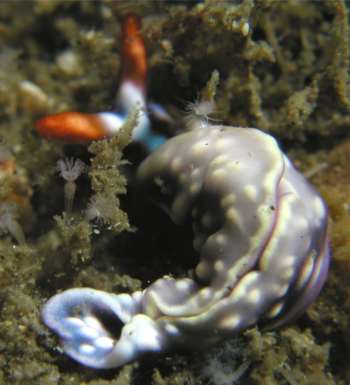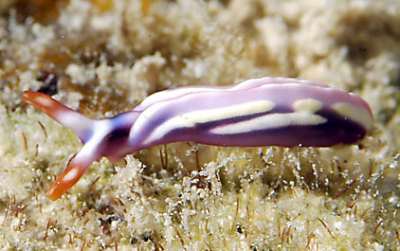

Thuridilla albopustulosa
Gosliner, 1995
Order: SACOGLOSSA
Superfamily: ELYSIOIDEA
Family: Elysiidae
DISTRIBUTION
Philippines, Papua New Guinea, Indonesia, Aldabra Atoll & South Africa
PHOTO
Upper: Zushi (near Hayama), Sagami Bay, Japan. 8 Jun 2003, Depth: 27m. Size: 15mm. Photo: Yukari Sato.
Lower: Malapascua Island, Philippines, 6 March 2004. Approx 20-25mm long. Depth: 4-5 metres. Photo: Paul Osmond.
The living animals are light blue with scattered translucent blackish pigment especially near the foot. There is an opaque white band along the edge of the parapodia and the parapodia are covered with scattered opaque white or cream spots or longitudinal bands. The dorsal part of the head is opaque white and the white pigment forms a V shape running into the basal third of the rhinophores. The outer two-thirds of the rhinophores are bright orange red with a thin, often broken, median white line. The red pigment extends farther basally on the outer side of the rhinophore than on the inner side. The anterior margin of the foot is blue.
Thuridilla vatae is quite similar in colour to T. albopustulosa and both species are unique among species of Thuridilla in having connections between the lateral and posterior pericardial vessels. According to Gosliner, the radular teeth of T. vatae appear to be more finely denticulate than those of T. albopustulosa and the penial papilla of one specimen of T. albopustulosa had a constriction in the middle of its length. At present, it is not known whether this is a consistent difference between the two species.
Aspects of the coloration of T. vatae differ consistently from that of T. albopustulosa. In T. vatae, the ground color is a dark gray to black while that of T. albopustulosa is blue. The parapodia of T. vatae are ornamented with black and yellow spots, while those of T. albopustulosa are white or cream. In T. vatae, white pigment covers most of the length of rhinophores and only the apex is red. In T. albopustulosa, the majority of the rhinophores are red rather than white. In T. vatae, the red pigment is a solid transverse band, while in T. albopustulosa there are median white patches or a line within the band.
Reference:
• The genus Thuridilla (Opisthobranchia: Elysiidae) from the tropical Indo-Pacific, with a revision of the phylogeny and systematics of the Elysiidae. Proceedings of the California Academy of Sciences 49(1): 1-54.
Rudman, W.B., 2003 (July 3) Thuridilla albopustulosa Gosliner, 1995. [In] Sea Slug Forum. Australian Museum, Sydney. Available from http://www.seaslugforum.net/factsheet/thuralbo
Related messages
-
Thuridilla albopustulosa from Indonesia
From: Roberto Sozzani, May 4, 2005 -
Thuridilla albopustulosa found Southern Queensland
From: Gary Cobb, March 8, 2005 -
Thuridilla albopustulosa from the Philippines
From: Paul Osmond, March 24, 2004 -
Thuridilla albopustulosa from Japan
From: Yukari Sato, November 16, 2003 -
Thuridilla albopustulosa from Japan
From: Fukuyo Yoshinori , July 6, 2003
